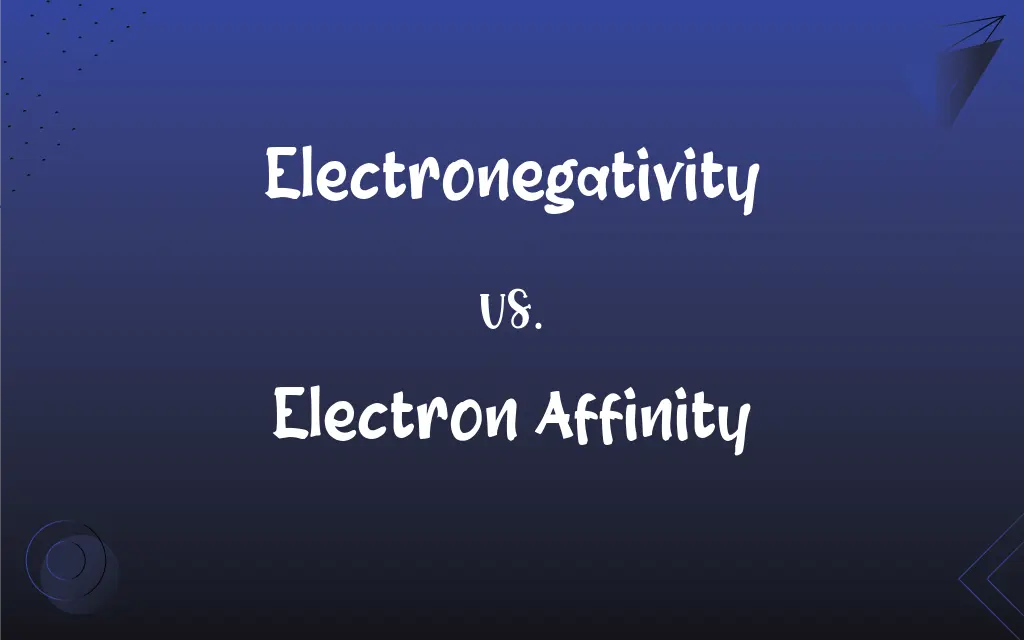Electronegativity vs. Electron Affinity: What's the Difference?
Edited by Aimie Carlson || By Harlon Moss || Published on November 28, 2023
"Electronegativity measures an atom's tendency to attract shared electrons, while electron affinity is the energy change when an atom gains an electron."

Key Differences
Electronegativity is a chemical property that describes the ability of an atom to attract electrons towards itself in a chemical bond. While, electron affinity refers to the amount of energy released or absorbed when an electron is added to a neutral atom to form a negative ion.
The concept of electronegativity is important in predicting the nature of chemical bonds, with higher electronegativity indicating stronger attraction for bonding electrons. Electron affinity, on the other hand, provides insight into the reactivity of an element, especially in gaining electrons.
Electronegativity is a dimensionless quantity and is often compared relative to other elements, using scales such as the Pauling scale. Whereas, electron affinity is measured in units of energy per mole, such as kilojoules per mole (kJ/mol) or electronvolts (eV).
While electronegativity is used to predict the type of bond (ionic or covalent) and bond polarity, electron affinity is typically considered when discussing the formation of negative ions and the stability of the resulting ions.
Elements with high electronegativity, like fluorine, are more likely to attract electrons in a bond. Elements with high electron affinity, like chlorine, tend to release more energy when gaining an electron, making them more likely to form negative ions.
ADVERTISEMENT
Comparison Chart
Definition
Atom's ability to attract shared electrons
Energy change when atom gains an electron
Measurement
Relative scale (e.g., Pauling scale)
Energy units (e.g., kJ/mol, eV)
Role in Bonding
Determines bond type and polarity
Indicates tendency to form negative ions
Key Elements
High in nonmetals like fluorine
High in halogens like chlorine
Application
Used in predicting bond nature
Considered in reactivity and ion formation
ADVERTISEMENT
Electronegativity and Electron Affinity Definitions
Electronegativity
Indicates bond polarity.
Electronegativity differences create ionic bonds.
Electron Affinity
Indicates formation of negative ions.
High electron affinity leads to anions.
Electronegativity
Measure of an atom's ability to attract bonding electrons.
Oxygen's high electronegativity makes water polar.
Electron Affinity
Higher in halogens.
Halogens typically have high electron affinity.
Electronegativity
Affects molecule shape.
Electronegativity differences shape molecular geometry.
Electron Affinity
Measured in energy units.
Electron affinity is expressed in kJ/mol.
Electronegativity
Relative scale without units.
Fluorine is the most electronegative element.
Electron Affinity
Energy change on gaining an electron.
Chlorine releases energy upon electron gain.
Electronegativity
Higher in nonmetals.
Nonmetals generally have higher electronegativity.
Electron Affinity
Affects element reactivity.
Elements with high electron affinity are more reactive.
Electronegativity
(chemistry) The tendency, or a measure of the ability, of an atom or molecule to attract electrons when forming bonds.
Electronegativity
(chemistry) the tendency of an atom or radical to attract electrons in the formation of an ionic bond
FAQs
Can electronegativity predict molecular shape?
Yes, it helps in predicting molecular geometry.
Does high electron affinity mean high reactivity?
Often, especially for nonmetals.
What is the most electronegative element?
Fluorine.
Does electronegativity increase across a period?
Yes, it typically increases from left to right.
How does electronegativity affect ionic bonds?
High electronegativity differences lead to ionic bonds.
Is electronegativity a periodic trend?
Yes, it shows predictable trends in the periodic table.
Is high electron affinity associated with ionization energy?
Yes, elements with high electron affinity often have high ionization energies.
Is electron affinity always negative?
No, it can be positive or negative, indicating energy release or absorption.
Can electron affinity be zero?
Yes, for noble gases it's often close to zero.
Are electronegativity values constant?
They can vary slightly depending on the bonding environment.
Is electron affinity a bulk property?
No, it's an atomic property.
Does electron affinity increase down a group?
It generally decreases down a group.
How is electronegativity used in chemical reactions?
It helps predict how atoms will bond and react.
Can electronegativity indicate acid strength?
Yes, higher electronegativity often correlates with stronger acids.
Can electron affinity be used to predict molecule stability?
Yes, especially for negative ion stability.
Do metals have high electron affinity?
No, they generally have lower electron affinity.
Are electron affinity values always positive for nonmetals?
Mostly, but there are exceptions.
Do inert gases have high electron affinity?
No, they have low electron affinities.
Do covalent bonds involve electronegativity?
Yes, differences in electronegativity affect covalent bond polarity.
Does electronegativity affect boiling points?
Indirectly, as it influences molecular interactions.
About Author
Written by
Harlon MossHarlon is a seasoned quality moderator and accomplished content writer for Difference Wiki. An alumnus of the prestigious University of California, he earned his degree in Computer Science. Leveraging his academic background, Harlon brings a meticulous and informed perspective to his work, ensuring content accuracy and excellence.
Edited by
Aimie CarlsonAimie Carlson, holding a master's degree in English literature, is a fervent English language enthusiast. She lends her writing talents to Difference Wiki, a prominent website that specializes in comparisons, offering readers insightful analyses that both captivate and inform.







































































